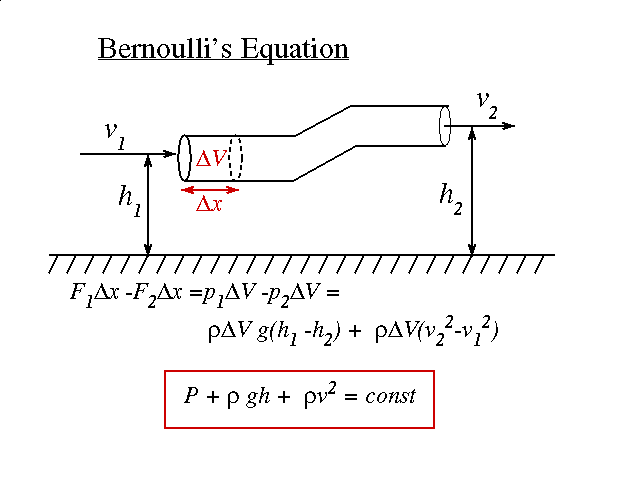Welcome to
the Bernoulli Room
of the Haar's Cyber Sciplace
A diversified site for science and democracy!
the Bernoulli Room
of the Haar's Cyber Sciplace
A diversified site for science and democracy!
You are here in the Bernoulli Room.
Let us first introduce to you a textbook version
of the Bernoulli Equation.
The following illustrative graph was copied from this Cyber Lecture.

Basically this equation renders energy conservaion
such that in a fluid flow
the sum of it's
pressure, potential and kinetic energies
remains constant.
So what does it really mean?
A neat explanation is given by Dr. Michael Guillen
in his recent book Five Equations that Changed the World:
"... in terms of a lobbyist trying to persuade senators
to vote her way on some political issue.
The more swiftly she made her rounds
-- the more she divided her time --
the less
she was able to pressure each politician;
similarly, in the case of a fluid making the rounds,
the faster its speed, the smaller was
the pressure it exerted on its surroundings."
Here's an interesting question and answer, taken from
the well-known book "How Things Work: the Physics of Everyday Life" by Lou Bloomfield,
that really illustrates Bernoulli effect:
Question:
Why does a hose squirt further when you cover
the hole with your thumb?
Answer:
The water entering the hose has a certain amount of energy per liter. That energy can be in one of three forms: pressure potential energy, gravitational potential energy, or kinetic energy. If you let it flow freely through the hose, most of that energy will become kinetic energy and the water will move quickly through the hose. But it will encounter frictional effects as it slides past the walls of the hose (its viscosity participates here) and it will convert much of its kinetic energy into thermal energy by the time it leaves the hose. However, if you pinch off the flow with your thumb, the water won't be able to convert its energy into kinetic form as it enters the hose. Most of the energy will remain as pressure potential energy. The water will move slowly through the hose and it will experience relatively little energy loss to frictional effects. Most of the energy will remain by the time the water reaches your thumb. Then, as the water flows past your thumb to the outside air, its pressure will drop suddenly and its energy will become kinetic energy. The water will spray out at very high speed.
Jump to this illustrative page for some other practical applications
of the Bernoulli Equation.
You can see by now that the Bernoulli Equation is so
fundamentally associated with our daily life,
we have more or less taken most of it for granted.
Did you know how to pitch a curve-ball when playing baseball?
Check here to find out how
does the Bernoulli Principle can help.
As part of the National Air and Space Museum,
this cool site accounts everything about
how things fly,
based on the Bernoulli principle, of course.
Now who in the world is this Bernoulli anyway?
Well, there are quite a number of famous Bernoulli's
in the physics and mathematics world.
One needs a Bernoulli family tree to keep track all of them.
The one that has everything to do with
the development of hydrodynamics,
is really that of Daniel Bernoulli (1700-1782).
So it is to Daniel, the father of hydrodynamics,
that this room is respectfully dedicated.
in his recent book Five Equations that Changed the World:
to vote her way on some political issue.
The more swiftly she made her rounds
-- the more she divided her time -- the less
she was able to pressure each politician;
similarly, in the case of a fluid making the rounds,
the faster its speed, the smaller was
the pressure it exerted on its surroundings."
the hole with your thumb?
of the Bernoulli Equation.
You can see by now that the Bernoulli Equation is so
fundamentally associated with our daily life,
we have more or less taken most of it for granted.
Check here to find out how does the Bernoulli Principle can help.
As part of the National Air and Space Museum,
this cool site accounts everything about how things fly,
based on the Bernoulli principle, of course.
Well, there are quite a number of famous Bernoulli's
in the physics and mathematics world.
One needs a Bernoulli family tree to keep track all of them.
The one that has everything to do with
the development of hydrodynamics,
is really that of Daniel Bernoulli (1700-1782).
So it is to Daniel, the father of hydrodynamics,
that this room is respectfully dedicated.
We searched through the cyber universe,
to look for interesting, cool, and fun scientific stuffs,
and gathering them here for everyone to enjoy.
Hopefully your visit to this place
can be an intellectually stimulating one.
If you have any comments and suggestions,
please feel free to contact
[email protected].
please feel free to contact [email protected].
Whereto?
Wherever!